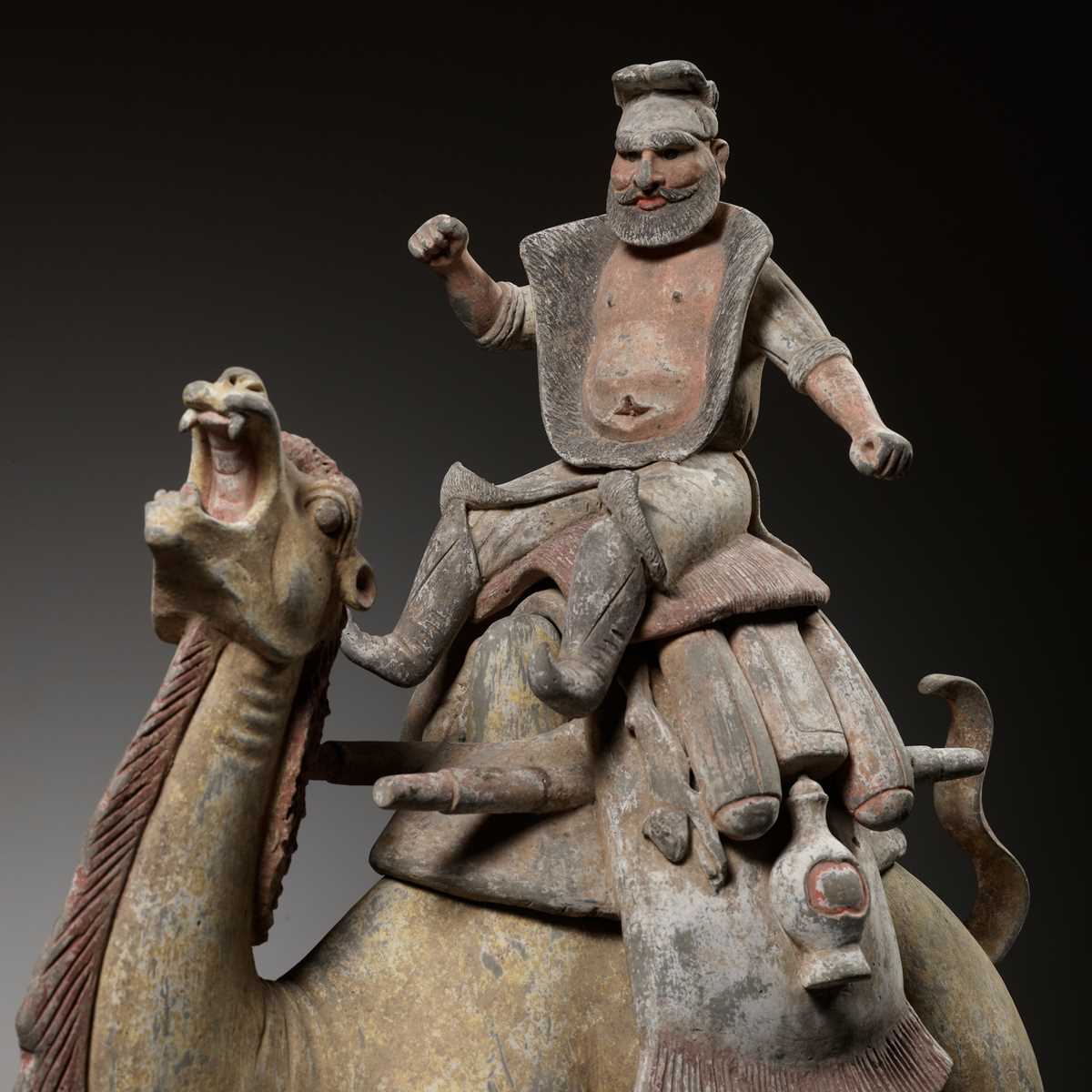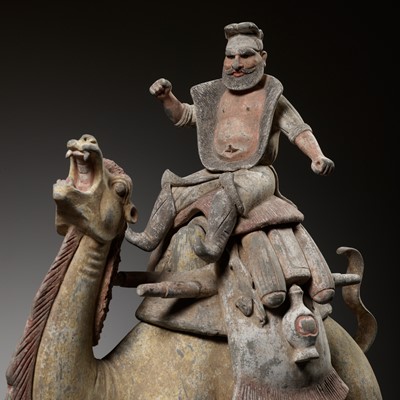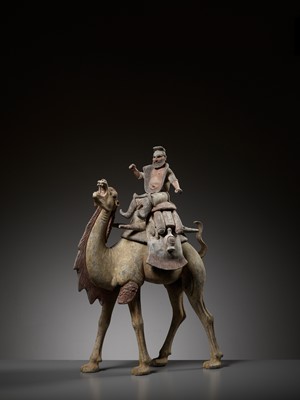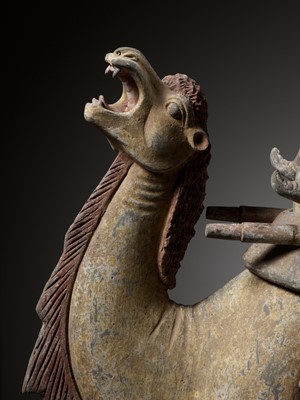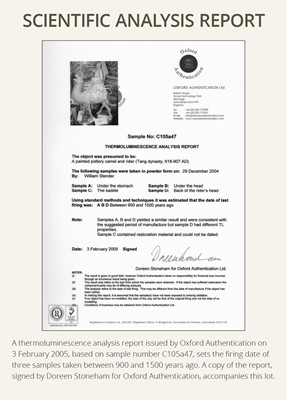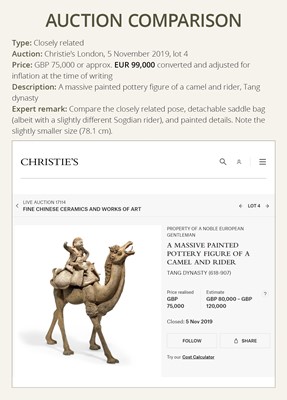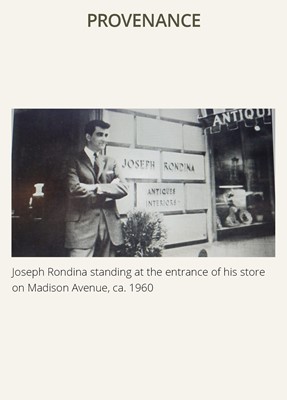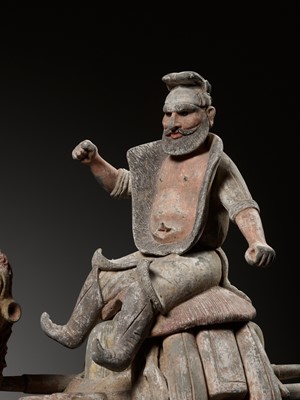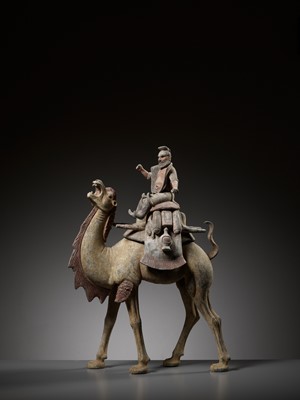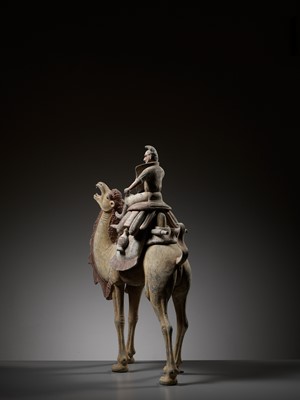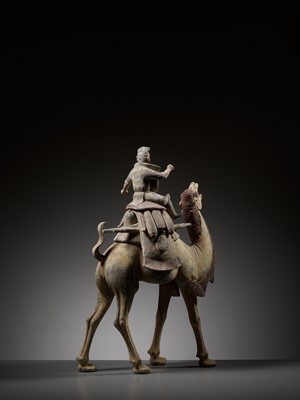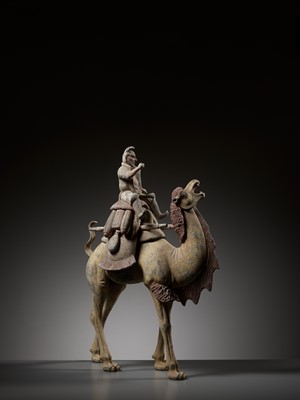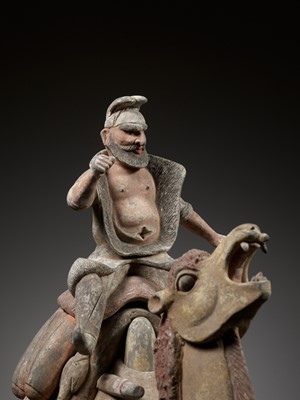9th Mar, 2023 13:00
TWO-DAY AUCTION - Fine Chinese Art / 中國藝術集珍 / Buddhism & Hinduism
69
A MASSIVE PAINTED POTTERY FIGURE OF A BACTRIAN CAMEL AND SOGDIAN RIDER, TANG DYNASTY
唐代彩繪胡人騎駱駝陶俑
Sold for €23,400
including Buyer's Premium
Scientific Analysis Report: A thermoluminescence analysis report issued by Oxford Authentication on 3 February 2005, based on sample number C105a47, sets the firing date of three samples taken between 900 and 1500 years ago (one further sample contained restoration material and could not be dated). A copy of the report, signed by Doreen Stoneham for Oxford Authentication, accompanies this lot.
China, 618-907. The large camel is modeled with its head slightly turned to the left, protruding eyes, flaring nostrils and ears lying against its neck, its mouth held wide open with the tongue in the center. A detachable saddle bag hangs between its humps and is surmounted by a bearded Turk or Sogdian rider, wearing a distinctively pointed hat, with one arm raised to hold the reins.
Provenance: From the collection of Joseph Rondina (1927-2022), who was born into a first-generation Florentine-American family in Auburn, upstate New York. Returning to the U.S. after being stationed in Berlin at the end of the Second World War, he studied at the Whitman School of Design before opening Joseph Rondina Antiques on Madison Avenue in Manhattan’s Upper East Side in 1957. In the beginning, his interests focused primarily on European 18th-century decorative arts and furniture, over time developing to include Chinese, Korean, Indian, Thai, Cambodian, Persian and Japanese art, bringing a more esoteric and exotic style to the market. His clientele included stars of the stage and screen, royalty, notables, dignitaries, and denizens of the social register from the United States and abroad.
Condition: Some old repairs and touchups as generally expected from Tang dynasty excavations. Losses, fissures, and encrustations. Drilled holes from sample-taking. Overall very good condition.
Dimensions: Height 84.3 cm
The Tang dynasty is undoubtedly one of the most artistically exciting periods in China's long history. The arts are characterized by their diversity, the cosmopolitan nature of their design and the high technical skill employed in their manufacture as this pottery example amply demonstrates. In the first half of this dynasty, up to the An Lushan rebellion of 756, the level of luxury enjoyed by the court and the Tang elite ensured the production of a wide range of goods of the highest quality. As China prospered as a result of trade with the west along the famous Silk Road, camels became increasingly important for the transport of wares, since these impressive animals could carry heavy loads over long distances, surviving several days without water. As their large and broad feet did not sink easily into the sand, they became known as 'the ships of the desert'. Many camels were imported from the states of the Tarim basin, Eastern Turkmenistan and Mongolia and are known as Bactrian camels. The Tang civil servants created a special office to supervise their breeding and services. It seems that no pottery examples showing Chinese riders have been excavated. Perhaps only the Central Asian foreigners were able to tame and guide the camels.
Literature comparison:
A related large painted pottery group of camel and foreign rider, dressed in a fur coat and wearing a large pointed hat, excavated from the tomb of Wang Chen (buried 679), Changzhi, Shaanxi province in 1954 and now in the Museum of Chinese History, Beijing, is illustrated by Li Jian (ed.), The Glory of the Silk Road, Art from Ancient China, The Dayton Art Institute, 2003, p. 170, pl. 85.
Auction result comparison:
Type: Closely related
Auction: Christie’s London, 5 November 2019, lot 4
Price: GBP 75,000 or approx. EUR 99,000 converted and adjusted for inflation at the time of writing
Description: A massive painted pottery figure of a camel and rider, Tang dynasty
Expert remark: Compare the closely related pose, detachable saddle bag (albeit with a slightly different Sogdian rider), and painted details. Note the slightly smaller size (78.1 cm).
唐代彩繪胡人騎駱駝陶俑
中國,618-907年。駱駝背上的胡人深目、高鼻、絡腮鬍,雙眼緊盯前方,頭戴氈帽,身穿翻領棉毛襖,袒胸露乳,雙袖捲起,雙手持韁繩狀,腳踏棉鞋。駝囊上掛有一隻扁壺,是胡人平常飲水的水壺。駱駝體型高大、粗壯,張嘴作嘶鳴狀,四肢挺拔剛健,闊步向前。
科學檢測報告:隨附牛津檢測所Doreen Stoneham 2005年2月3日出局的熱釋光檢測複印本,樣本號 C105a47,確認陶俑為900至1500 年前所造 (另外一個修復材料樣本無法確認時間)。
來源:美國紐約Joseph Rondina收藏。Joseph Rondina (1927-2022年) 出生於紐約州北部奧本的第一代佛羅倫薩美國人家庭。第二次世界大戰結束後駐紮在柏林,後回到美國。之後他在惠特曼設計學院學習,於 1957 年在曼哈頓上東區的麥迪遜大街開設了 Joseph Rondina 古董店。一開始,他的興趣主要集中在歐洲十八世紀的裝飾藝術和家具。隨著時間的推移,他開始收集印度、中國、韓國和日本的藝術。他的客戶包括來自美國和國外的銀幕明星、皇室成員、名人、政要和社會名流。
品相:有修復、缺損、裂縫和結殼,取樣鑽孔,總體狀況非常好。
尺寸:高84.3 厘米
唐朝無疑是中國歷史長河上最令人激動的藝術時期之一。如本拍品實例充分表現的那樣,藝術的特徵在於多樣性、設計的國際化以及其製造中採用的高技術。從唐初到756年的安祿山叛亂,宮廷和唐朝精英階層享有的富裕水平確保了各種最高品質商品的生產。絲綢之路更是擴大了與西方的貿易,中國繁榮了,駱駝在商品運輸中變得越來越重要,因為這動物可以長途搬運重物,無水生存數天。由於它們大而寬的腳不易沉入沙灘,因此被稱為“沙漠之船”。許多駱駝是從塔里木盆地、土庫曼斯坦東部和蒙古進口的,被稱為雙峰駝。唐代甚至建立了一個專門官署,監督其繁殖和運作。目前似乎還沒有發掘出顯示中國駝俑的實例。也許只有這些中亞人才能馴服和引導駱駝。
文獻比較:
一件相近的大型一群駱駝和外國騎士,身穿裘皮大衣,頭戴尖頂大禮帽,1954年出土於陝西長治王城 (墓號 679),收藏於北京中國國家博物館,見Li Jian (ed.),《The Glory of the Silk Road,Art from Ancient China,The Dayton Art Institute》,2003年,頁170,圖85。
拍賣結果比較:
形制:非常相近
拍賣:倫敦佳士得,2019年11月5日,lot 4
價格:GBP 75,000(相當於今日EUR 99,000)
描述:唐胡人騎駱駝陶佣
專家評論:比較非常相近的姿勢、可拆卸的馬鞍包(儘管粟特騎手略有不同),以及彩繪細節。請注意尺寸稍小(78.1 厘米)。
Scientific Analysis Report: A thermoluminescence analysis report issued by Oxford Authentication on 3 February 2005, based on sample number C105a47, sets the firing date of three samples taken between 900 and 1500 years ago (one further sample contained restoration material and could not be dated). A copy of the report, signed by Doreen Stoneham for Oxford Authentication, accompanies this lot.
China, 618-907. The large camel is modeled with its head slightly turned to the left, protruding eyes, flaring nostrils and ears lying against its neck, its mouth held wide open with the tongue in the center. A detachable saddle bag hangs between its humps and is surmounted by a bearded Turk or Sogdian rider, wearing a distinctively pointed hat, with one arm raised to hold the reins.
Provenance: From the collection of Joseph Rondina (1927-2022), who was born into a first-generation Florentine-American family in Auburn, upstate New York. Returning to the U.S. after being stationed in Berlin at the end of the Second World War, he studied at the Whitman School of Design before opening Joseph Rondina Antiques on Madison Avenue in Manhattan’s Upper East Side in 1957. In the beginning, his interests focused primarily on European 18th-century decorative arts and furniture, over time developing to include Chinese, Korean, Indian, Thai, Cambodian, Persian and Japanese art, bringing a more esoteric and exotic style to the market. His clientele included stars of the stage and screen, royalty, notables, dignitaries, and denizens of the social register from the United States and abroad.
Condition: Some old repairs and touchups as generally expected from Tang dynasty excavations. Losses, fissures, and encrustations. Drilled holes from sample-taking. Overall very good condition.
Dimensions: Height 84.3 cm
The Tang dynasty is undoubtedly one of the most artistically exciting periods in China's long history. The arts are characterized by their diversity, the cosmopolitan nature of their design and the high technical skill employed in their manufacture as this pottery example amply demonstrates. In the first half of this dynasty, up to the An Lushan rebellion of 756, the level of luxury enjoyed by the court and the Tang elite ensured the production of a wide range of goods of the highest quality. As China prospered as a result of trade with the west along the famous Silk Road, camels became increasingly important for the transport of wares, since these impressive animals could carry heavy loads over long distances, surviving several days without water. As their large and broad feet did not sink easily into the sand, they became known as 'the ships of the desert'. Many camels were imported from the states of the Tarim basin, Eastern Turkmenistan and Mongolia and are known as Bactrian camels. The Tang civil servants created a special office to supervise their breeding and services. It seems that no pottery examples showing Chinese riders have been excavated. Perhaps only the Central Asian foreigners were able to tame and guide the camels.
Literature comparison:
A related large painted pottery group of camel and foreign rider, dressed in a fur coat and wearing a large pointed hat, excavated from the tomb of Wang Chen (buried 679), Changzhi, Shaanxi province in 1954 and now in the Museum of Chinese History, Beijing, is illustrated by Li Jian (ed.), The Glory of the Silk Road, Art from Ancient China, The Dayton Art Institute, 2003, p. 170, pl. 85.
Auction result comparison:
Type: Closely related
Auction: Christie’s London, 5 November 2019, lot 4
Price: GBP 75,000 or approx. EUR 99,000 converted and adjusted for inflation at the time of writing
Description: A massive painted pottery figure of a camel and rider, Tang dynasty
Expert remark: Compare the closely related pose, detachable saddle bag (albeit with a slightly different Sogdian rider), and painted details. Note the slightly smaller size (78.1 cm).
唐代彩繪胡人騎駱駝陶俑
中國,618-907年。駱駝背上的胡人深目、高鼻、絡腮鬍,雙眼緊盯前方,頭戴氈帽,身穿翻領棉毛襖,袒胸露乳,雙袖捲起,雙手持韁繩狀,腳踏棉鞋。駝囊上掛有一隻扁壺,是胡人平常飲水的水壺。駱駝體型高大、粗壯,張嘴作嘶鳴狀,四肢挺拔剛健,闊步向前。
科學檢測報告:隨附牛津檢測所Doreen Stoneham 2005年2月3日出局的熱釋光檢測複印本,樣本號 C105a47,確認陶俑為900至1500 年前所造 (另外一個修復材料樣本無法確認時間)。
來源:美國紐約Joseph Rondina收藏。Joseph Rondina (1927-2022年) 出生於紐約州北部奧本的第一代佛羅倫薩美國人家庭。第二次世界大戰結束後駐紮在柏林,後回到美國。之後他在惠特曼設計學院學習,於 1957 年在曼哈頓上東區的麥迪遜大街開設了 Joseph Rondina 古董店。一開始,他的興趣主要集中在歐洲十八世紀的裝飾藝術和家具。隨著時間的推移,他開始收集印度、中國、韓國和日本的藝術。他的客戶包括來自美國和國外的銀幕明星、皇室成員、名人、政要和社會名流。
品相:有修復、缺損、裂縫和結殼,取樣鑽孔,總體狀況非常好。
尺寸:高84.3 厘米
唐朝無疑是中國歷史長河上最令人激動的藝術時期之一。如本拍品實例充分表現的那樣,藝術的特徵在於多樣性、設計的國際化以及其製造中採用的高技術。從唐初到756年的安祿山叛亂,宮廷和唐朝精英階層享有的富裕水平確保了各種最高品質商品的生產。絲綢之路更是擴大了與西方的貿易,中國繁榮了,駱駝在商品運輸中變得越來越重要,因為這動物可以長途搬運重物,無水生存數天。由於它們大而寬的腳不易沉入沙灘,因此被稱為“沙漠之船”。許多駱駝是從塔里木盆地、土庫曼斯坦東部和蒙古進口的,被稱為雙峰駝。唐代甚至建立了一個專門官署,監督其繁殖和運作。目前似乎還沒有發掘出顯示中國駝俑的實例。也許只有這些中亞人才能馴服和引導駱駝。
文獻比較:
一件相近的大型一群駱駝和外國騎士,身穿裘皮大衣,頭戴尖頂大禮帽,1954年出土於陝西長治王城 (墓號 679),收藏於北京中國國家博物館,見Li Jian (ed.),《The Glory of the Silk Road,Art from Ancient China,The Dayton Art Institute》,2003年,頁170,圖85。
拍賣結果比較:
形制:非常相近
拍賣:倫敦佳士得,2019年11月5日,lot 4
價格:GBP 75,000(相當於今日EUR 99,000)
描述:唐胡人騎駱駝陶佣
專家評論:比較非常相近的姿勢、可拆卸的馬鞍包(儘管粟特騎手略有不同),以及彩繪細節。請注意尺寸稍小(78.1 厘米)。
Zacke Live Online Bidding
Our online bidding platform makes it easier than ever to bid in our auctions! When you bid through our website, you can take advantage of our premium buyer's terms without incurring any additional online bidding surcharges.
To bid live online, you'll need to create an online account. Once your account is created and your identity is verified, you can register to bid in an auction up to 12 hours before the auction begins.
Intended Spend and Bid Limits
When you register to bid in an online auction, you will need to share your intended maximum spending budget for the auction. We will then review your intended spend and set a bid limit for you. Once you have pre-registered for a live online auction, you can see your intended spend and bid limit by going to 'Account Settings' and clicking on 'Live Bidding Registrations'.
Your bid limit will be the maximum amount you can bid during the auction. Your bid limit is for the hammer price and is not affected by the buyer’s premium and VAT. For example, if you have a bid limit of €1,000 and place two winning bids for €300 and €200, then you will only be able to bid €500 for the rest of the auction. If you try to place a bid that is higher than €500, you will not be able to do so.
Online Absentee and Telephone Bids
You can now leave absentee and telephone bids on our website!
Absentee Bidding
Once you've created an account and your identity is verified, you can leave your absentee bid directly on the lot page. We will contact you when your bids have been confirmed.
Telephone Bidding
Once you've created an account and your identity is verified, you can leave telephone bids online. We will contact you when your bids have been confirmed.
Classic Absentee and Telephone Bidding Form
You can still submit absentee and telephone bids by email or fax if you prefer. Simply fill out the Absentee Bidding/Telephone bidding form and return it to us by email at office@zacke.at or by fax at +43 (1) 532 04 52 20. You can download the PDF from our Upcoming Auctions page.
How-To Guides
How to Create Your Personal Zacke Account
How to Register to Bid on Zacke Live
How to Leave Absentee Bids Online
How to Leave Telephone Bids Online
中文版本的操作指南
创建新账号
注册Zacke Live在线直播竞拍(免平台费)
缺席投标和电话投标
Third-Party Bidding
We partner with best-in-class third-party partners to make it easy for you to bid online in the channel of your choice. Please note that if you bid with one of our third-party online partners, then there will be a live bidding surcharge on top of your final purchase price. You can find all of our fees here. Here's a full list of our third-party partners:
- 51 Bid Live
- EpaiLive
- ArtFoxLive
- Invaluable
- LiveAuctioneers
- the-saleroom
- lot-tissimo
- Drouot
Please note that we place different auctions on different platforms. For example, in general, we only place Chinese art auctions on 51 Bid Live.
Bidding in Person
You must register to bid in person and will be assigned a paddle at the auction. Please contact us at office@zacke.at or +43 (1) 532 04 52 for the latest local health and safety guidelines.
